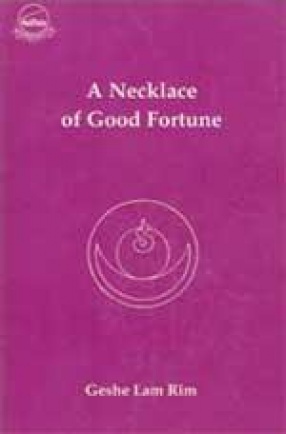Gashe Lam Rim’s A Necklace of Good Fortune which propounds the Buddhist theory of Karma and past and future lives carries a rare significance uncommon among such writings. Lucid and sincere in his approach and analysis, A Necklace of Good Fortune stands out at the same time as the spiritual and political testimony of the true courage of a Tibetan Buddhist monk who singlehandedly challenged the formidable censorship of Mao’s Great Proletarian Cultural Revolution in Tibet and defied the Chinese anti-religion propaganda with a scientific religious work that is at once bold and inspiring. Geshe Lam Rim is one of those Tibetan Buddhist monks who, even under the abusive and oppressive times of the Cultural Revolution and subsequent imprisonment by the Chinese, courageously withstood the terrors of the Chinese occupation with his undying faith in the Buddha and the Tibetan Buddhist heritage. In his own words: “At this time of the setting of the Sun of Dharma, even if one has but the light of a firefly, still one must do whatever one can rather than let darkness prevail.†A Necklace of Good Fortune is born out of this admirable sense of duty and dedication towards the Buddha Dharma at a time when the very survival of Tibetan culture and religion is threatened by the Chinese atheist ideology.
A Necklace of Good Fortune
$9.90
$11.00
In stock
Free & Quick Delivery Worldwide
All orders amounting to US$ 50 or more qualify for Free Delivery Worldwide. For orders less than US$ 50, we offer Standard Delivery at $14 per book.
ABOUT THE AUTHOR Geshe Lam Rim
Geshe Lam Rim was born in 1922 in the district of Gyal Thang, eastern Tibet. As a young monk in the monastery at Gyal Thang he was able to recite many texts and prayers upon hearing them only once and cuold effortlessly perform many complicated rituals and rites. As early as the age of 11. having been profoundly moved by stories of past great yogis, he spend many sleepless nights with a burning desire to retreat into isolation and there carry on an intensive practice of meditation. At the age of 20 he met his spirtual master, The renowned Abbu Rinpoche, from whom he received extensive teachings on the stages of the path. During this period there arose a conflict between the necessity to return to his home life in order to support his parents and repay family debts, and the desire to give himself over completely to his studies of Dharma. Geshe Lam Rim thought to emulate his spiritual master by retreating into the mountains and there meditate on the stages of the Path. Upon setting out he heard the music of stringed instruments playing and thought this very auspicious, but his fellow monks, moved a s if by black forces, spoke out against his leaving the monastery at such an early age. it was the custom there taht after having spent 12 years in the monastery a monk would then join one of the three great monastic universities in Lhasa. Two years after returning, at the age of 22 he set out for Lhasa and on the way again sought the advice of his spiritual master. during his long period of study at Drepung he sought to put into practice the conduct of the four superiors and thus he viewed contributions, even his food rations, as unfitting to accept. He thereby forced upon humself many deprivations, making do with only hot water occasionally supplemented by mantric pills. in 1959, when the Chinese invaded, Geshe Lam Rim was imprisoned for two years. During his imprisonment, though food was extremely scarce, he shared his meagre rations with his fellow prisoners and was well liked by all. upon his rease he returned to Drepung and ebgan again to study and retreat. During the Cultural Revolution of 1996 onwards the Tibetans were forced to dostroy the praye halls, images and texts of the monastery. At a meeting Geshe Lam Rim spoke out against such action, saying that he would sooner go to prison than desecrate the monastery, and failing that, he would kill himslef. after this outburst the Chinese constantly abused him and he was forced to perform menial labor. Then the Chinese ordered the Tibetans to surrender to them all religious articles and texts or be prosecuted. Geshe Lam Rim again spoke out, and declared that if the Tibetans were afraid they shoudl give all their sacred possessions to him. He did not hide them away in the corner of some dark room, but placed all the images and texts offered to him upon his alter. When visitors came they often wept and some almost fainted when they saw his shrine aglow with butterlamps and adorned with the collection of sacred images and texts. it was at this time that the Chinese began a propaganda campaign against religion, denying the existence of the Three Jewels, gods, past and future lives, and actions and their results. This propaganda moved many people to commit extremely irreligious actions. Geshe Lam Rim could not bear to look on and do nothing.
reviews
0 in total
Review by Anonymous
Be the first to review “A Necklace of Good Fortune” Cancel reply
You must be logged in to post a review.
Bibliographic information
Title
A Necklace of Good Fortune
Author
Edition
Reprint
Publisher
ISBN
8186470123
Length
xiii+42p., 22cm.
Subjects





There are no reviews yet.